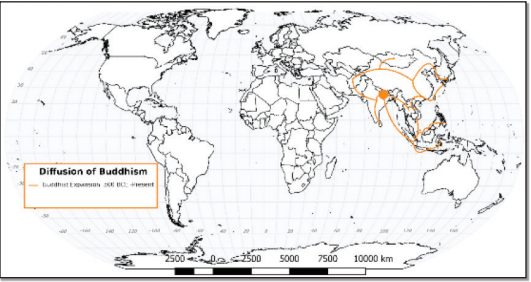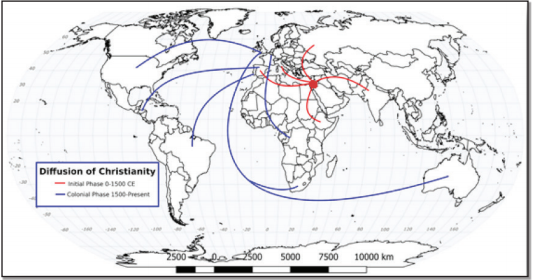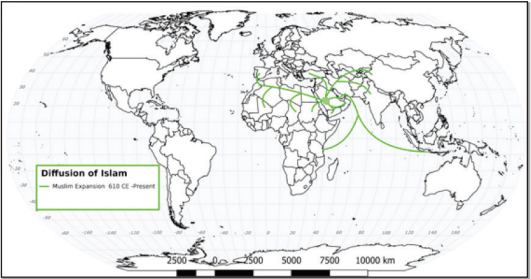55 6.3 DIFFUSION OF MAJOR RELIGIONS
Religion uses nearly all forms of diffusion to reproduce itself across space. Hierarchical diffusion generally involves the conversion of a king, emperor, or other leader who then influences others to convert. Relocation diffusion, often through missionary work, brings “great leaps forward” by crossing space to secure footholds in far-away places. Contagious diffusion is most often seen in a religious context as the result of direct proselytizing. All these forms of diffusion produce patterns of diffusion that are complex. It is impossible to know why certain religions have appeal in particular times or places, but they do, and that appeal can wear off over time.
Another important thing to remember is that the religious landscape is just a snapshot. In the same way that it has always changed, it will continue to do so. These maps can reinforce this idea in that they demonstrate the historical nature of current religious distributions. Remind yourself that these religious expansions occurred at different times. This will help explain why some places will become Buddhist or Christian at one point in history, but become Muslim at another.
6.3.1 The Diffusion of Buddhism
Buddhism originated near the current Nepalese-Indian border. Like many other religions, it spread in other directions, particularly to the south and east (Figure 6.12).

Figure 6.12 | Diffusion of Buddhism 12
This map shows the distinct waves of the diffusion of Buddhism.
Author | David Dorrell
Source | Original Work
License | CC BY SA 4.0
Due to its position as the oldest large, universalizing religion, Buddhism is a good example of the lifecycle of a religion. From its origins, the religion spread across what is now India and Nepal. It spread in all directions but looking at a current religious map reveals that the process did not end 1500 years ago. Much of its territory on the Indian subcontinent would become mostly Hindu or Muslim. To the east and south, however, the religion continued and expanded. It is not unusual for a religion to prove popular far from its place of origin. In fact, that is the key to a successful universalizing religion.
6.3.2 The Diffusion of Christianity
Christianity was founded in the eastern Mediterranean, although much like Buddhism, its greatest successes were found in other parts of the world (Figure 6.13). Christianity initially grew in areas dominated by the Roman Empire, but it would adapt and thrive in many places. With the collapse of the Empire, Christianity became the only source of social cohesion in Europe for centuries. Later, Christianity was promoted through the process of colonialism, and as such, it was modified by the process that distributed it. The spread of Christianity helped drive the process that created the modern world.

Figure 6.13 | Diffusion of Christianity 13
This map shows the distinct waves of the diffusion of Christianity, the initial wave from its foundation, and the subsequent wave associated with European Colonialism.
Author | David Dorrell
Source | Original Work
License | CC BY SA 4.0
6.3.3 The Diffusion of Islam
The most recent of the world’s largest religions, Islam is also the one that is expanding the fastest (Figure 6.14). This is not necessarily through conquest or conversion, but mostly through current demographics. Islam provides a blueprint for most aspects of life and as such, has often been associated with rapid expansion driven by military conquest. Although military conquest occurred in the past, military campaigns have been rare since the fall of the Ottoman Empire. The relative distributions of Buddhists, Christians, and Muslims have in fact changed little in half a millennium. Although there has been some migration of Muslims into western Europe, the percentages of Muslims in each country is small. France has the largest percentage of Muslims at 7.5%. To keep this in perspective, that is much lower than the percentage of Muslims in Spain in 1492.

Figure 6.14 | Diffusion of Islam 14
This map shows the distinct waves of the diffusion of Islam.
Author | David Dorrell
Source | Original Work
License | CC BY SA 4.0
